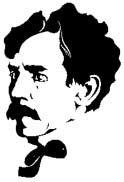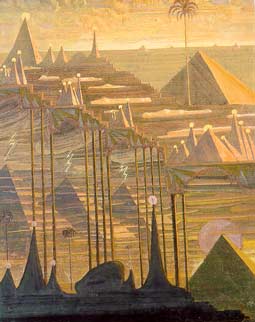SCRIABIN AND CHIURLIONIS: ON THE WAY TO
THE LIGHT-MUSIC SYNTHESIS
Vanechkina I.L.
 |
The creative work of the composer Scriabin and the painter Chiurlionis,
who lived and worked in Russia at the beginning of the century, is considered.
The features, likeness and difference of their ideas concerning the art
synthesis and interaction (specifically, in the field of "music vision")
are especially stressed.
|
|
The comparison of the creative work of Russian composer Scriabin
and the contemporary painters within the context of their allied
interests in the idea of "Gesamtkunstwerk" (specifically, the unity
of music and painting) has been a subject of researches
long since. In spite of this, there were few special publications
on this theme, especially in Russia, for the obvious reason that
there has been no opportunity to mention openly in the "positive
sense" the names of Kandinsky, Matiushin, Baranov-Rossine, etc.,
at least in official editions, up to the recent ten years
[1; 2].
Chiurlionis was more "lucky" in this sense. Almost all the monographs
on Scriabin are concerned with Chiurlionis' artworks, although, mostly,
in short. And much more obligatory are the references to Scriabin in the
literature devoted to his outstanding Lithuanian colleague and
like-minded artist.
In the West the name of Chiurlionis is less known. This can be seen, for
instance, from "Leonardo" publications: there was only one article on
Chiurlionis
[3],
and much more articles on Scriabin
([4, 5],
and the special "Prometheus" issue - "Leonardo", v.27, N 5, 1994).
Nevertheless, it would be worth noting the following fact, which is
of prime importance within the context of our research work.
Let it is concern of Russian editions only, but it has already become
a commonplace to put side by side the names "Scriabin - Chiurlionis"
in the researches on light-music art and its origins. Usually it is stated
in the popular literature that the first step towards light-music was done
by Scriabin "on the part of
music" and by Chiurlionis "on the part of painting". And it is particularly
underlined that the origin and realization of "light-symphony" (in Scriabin's
works) and "musical painting" (in Chiurlionis' works) took place almost
"synchronically" - in the first decade of the 20th century. Of course,
they were contemporaries, though they never met each other. It is a matter
of fact that Scriabin knew Chiurlionis from his paintings. Moreover,
the biographer of Scriabin mentions the painter's name in the row of
his "favourite persons". He wrote in the well-known memoirs: "One day A.N.
went to Chiurlionis' art exhibition and was very excited by his works.
The strange hallucinative pictures of this artist charmed him.
But there was no complete spiritual response because, to Scriabin's opinion,
"Chiurlionis is too illusive, lacks an actual power, he does not want his
dream to become a reality."
[6, p.144,248].
There are no evidences that Chiurlionis was familiar with Scriabin's music
and his colour music ideas. Thus, they moved towards the same aim but by
different ways and independently. Nevertheless, their fates, world outlooks
and even artworks have so much in common that some parallels in their
creative work come to one's mind inevitably.
To begin with, both of them were the outstanding musicians who have got the
world's recognition. Both were the versatile talents. Chiurlionis graduated
from two conservatoirs (in Warsaw and in Leipzig) and also from the Art School
in Warsaw. He created more than 200 musical compositions and dozens of paintings.
In some sense Chiurlionis was also a writer, as one can remember his poetic
versifications of the fairy-tales
[7].
Scriabin, likewise,
was not only a composer and pianist but also the author of philosophy-poetic
texts for his music compositions. It is necessary to note that his conception
of a new synthetic art reveals, to some extent, his potentials as a
light-painter, though he had not enough time for mastering in practice.
Besides this, both of them had a strongly expressed inclination for symbolic,
associative mode of thinking, the ability to perceive music "visually",
plastically and in certain colours (that was, in terms of that time, "colour
hearing" and, what is noteworthy, was of more systematic nature in Scriabin).
(See rather intricate discussions of Chiurlionis' colour hearing in
[8, p.213; 9, p.41] ).
The world outlook of Chiurlionis and Scriabin was formed at the same period
of time and in the same social surroundings when, side by side with the triumph
of faith in science and the revolutionary and radical tendencies, in the
intelligentsia strata the various idealistic attitudes of mind had been spread.
Like nowadays, spiritism, occultism and the God-seekers' movement came into
fashion. Both Chiurlionis and Scriabin (the latter more actively) took great
interest in the progress of political and social life. And although these
interests of them had different determinations, they both sympathized for
the Russian revolution of 1905 and, we may even say, declared it aloud.
Let us remember the hints at never printed dedication to Scriabin's
"Poem of Ecstasy". Whereas Chiurlionis, not participating in the
"revolutionary-liberating activities", embodied his ideals of democracy
in his artistic creative work, namely, in the diptych "Sorrow". (These facts
used to be gladly emphasized in the old Soviet times.)
Whatever it may be, the philosophical outlook played a great role in
Chiurlionis' creative work (so as in Scriabin's). His education and,
especially, early aroused interest in natural science "corrected" the naive
faith he had got in his childhood and aroused his aspiration for a more
deep cognition of the essence of human being. According to the evidences
of the contemporaries, Chiurlionis had a keen interest in the religions
of the ancient eastern peoples, particularly, of the ancient Indians
(apropos, so as Scriabin had), studied the theoretical works of the
philosophers and psychologists of the late 19 century - Wundt, Nietzsche,
etc. As a result, to the modern researchers opinion, in the mind of the
artist a peculiar world outlook was formed that assumed the existence of
the higher spiritual community or power that gives a sense to the Universe.
The statements of the artist himself, and also the symbolic and ideological
content of some of his works, give evidence for that. It is impossible to
frame Chiurlionis' philosophical views into clear-cut formulations because
they appear to be a specific artistic outlook, in which an emotional and
intuitive perception dominates. (This has obviously much in common with the
world outlook of Scriabin, though for the latter the position of creative
ego was more accented. At the same time, Scriabin's philosophical views
were more deep, well thought-out, "polished", and they were directly
realized in his creative work.) (See our work
[10].)
To put it more concrete, the development of the initial artistic inclinations
in young Chiurlionis was notably influenced by the late romantic and
symbolist art widely spread at that time. He was keen on the creative work
of such artists as A.Boecklin, F.Stuck, M.Klinger, O.Berdsley and such
writers as Y.Slovatzky, G.Ibsen, A.Andreev, E.Po. The circle of cultural
interests of Scriabin was very much alike, but, personally, it was limited
mainly to his close and attentive surroundings. And, to be serious, it is
necessary to note that both of them had symbolist moods of the specific
life-asserting ind coupled with the high pathos of "creation of the world"
(which was organically connected with the conception of cosmism expressed
equally in their artworks).
While comparing the aspirations for ideas of "Gesamtkunstwerk" in the great
Russian composer and the great Lithuanian painter, it is impossible to pass
by a comparison (though in short) of their musical creative work. This will
also give us an opportunity to find out some parallels.
Both Chiurlionis and Scriabin gave their frank sympathes to Chopin and Wagner
and, beside that, to Bach. Chopin's influence is the most evidently traceable
in their compositions. It is noticeable even from such formal indication as
their inclination to piano miniature. Let us remind that Scriabin never
created solo compositions for any instruments except piano and the two
thirds of Chiurlionis' musical heritage are piano pieces (and surely
they may be considered as the most original embodiments of his musical
ideas). The closeness is also notable in their common substantial ideas.
The image system of Chiurlionis' music, according to the opinion of the
researchers, has two main inherent states: burst and serenity.
And in Scriabin's music there is a similar polar opposition: ecstasy and
languor. Especially brightly their innovatory similarity manifested itself
in the area of harmony. (Although it is obvious that Chiurlionis, as the
first professional Lithuanian musician, was more restricted in this
direction, being engaged in the mission "to arrange music composed by the
folk"). It is characteristic of Scriabin's creative work of late period
that he used the complicated tonic as a whole complex of 6-7 sounds,
interpreted harmony as a rolled up melody and vice versa. Chiurlionis'
harmony of late period is also characterized by the complicated tonic,
nonsymmetrical modes, the use of the series principle. It is necessary to
note here that there was neither any interaction between the two composers,
nor any hypothetical influence of Schoenberg on them
[7, p.311; 8, p.59].
To continue the analysis of the influences experienced by Scriabin and
Chiurlionis, it is obvious that they both were strongly impressed by
Wagner's ideas of the art synthesis. They both inclined to the synthetic
genres. Scriabin has a day-dream, idee fixe: it was "Mysteria". And
Chiurlionis dreamed of creation of the first Lithuanian national opera.
It had to be entitled "Yurate - the Queen of Baltic". Especially it is
necessary to note here that their creative work had similar sources in the
ethic ideal of high morality: to create the first art work of
such "unifying" kind for his nation in the case of Chiurlionis, and for the
whole mankind - in the case of Scriabin. Neither of them had had enough time
to realize these plans. There are left only the designs of Scriabin's
"Preliminary Action" and Chiurlionis' opera libretto. But on the way to
these art works they both created original symphonic compositions.
Chiurlionis composed the one-movement symphonic poems "In the Forest" and
"The Sea". And Scriabin turned from the ordinary multi-part symphonies to
the symphonic poems - "The poem of Ecstasy" and "Prometheus" ("The Poem
of Fire"). Another two scores (and one of them - the poem "The Creation of
the World") had been lost during the war. By the way, the above mentioned
Chiurlionis' program composition had kind of "parallel" literary and
pictorial embodiments (the pictorial triptych "The Sea Sonata", the poetic
text "The Sea Tales"). Although, to note it particularly, he never fell
into the trivial music-painting inter-illustration (as some people think).
Meanwhile, Scriabin found another embodiment for the joint (gesamt) usage
of the various means, forms of the art thinking: their interaction was
realized within the bounds of the single composition.. The philosophical
program is embodied in "Prometheus" not only by means of music (including
man's voice) but also with the help of picturesque colourful light
organized in the course of time according to the laws of music, musical
form. So, to make a conclusion, we may assert, that even a short comparison
of the lives and creative work of these two artists, confirms that they had
very much in common. Within the context of the main interests of our
research work, this is their common aspiration for the art synthesis,
though the results of this aspiration appeared to be different: Scriabin
demonstrated the real synthesis of heterogeneous art means, while
Chiurlionis' synthesis was rather an interosculation
of the languages of various kinds of art thinking.
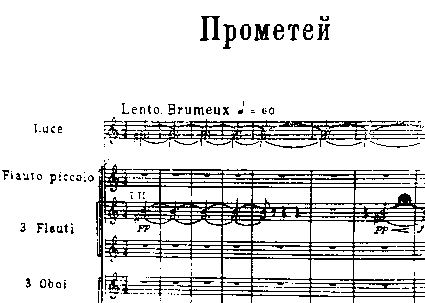 |
|
Fig.1. The beginning of the score of Scriabin's "Prometheus"
(on the top - the line "Luce", i.e. "Light")
|
|
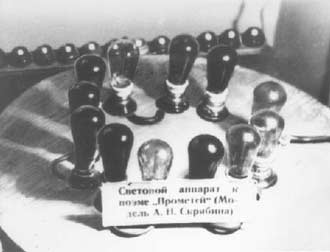
|
|
Fig.2. This is the simplest "light instrument", which Scriabin
had to use in developing a new art.
|
We more than once analyzed the subjective factors that led Scriabin to the
idea of light-music synthesis and the ways his intentions were realized in
his creative work. To remind in short, in "Prometheus" the colour dynamics
"visualized" the tonality-harmony plan which, in turn, was the "sound
embodiment" of the composition philosophical program.
[11].
Let us consider, in more details, how the interaction of arts was actually
revealed and, first of all, what served as the basis of Chiurlionis'
"musical painting"? This is of course, the congeniality in both fields of
art and, correspondingly, the brilliant associative thinking of the artist.
The free wielding of the material in both fields of art enabled
Chiurlionis to expand their limits extraordinarily without breaking them.
The most amazingly it showed in painting. Even in the early period of his
creative work he painted the cycles of pictures united by a common idea,
theme. Such is, for example, the cycle of seven pictures under the title
"Funeral" (or "The Funeral Symphony" as it had been named at first). The
musicality of the cycle is manifested not only by its title. Chiurlionis
used here the principle of the pictorial idea development in the course of
time, when the paintings are to be viewed in a certain sequence. Then, the
cycle reveals the development and collision of two images (contrasting in
their senses and colouring simultaneously) - the Sun as a symbol of Life
and the Coffin as a symbol of Death. But it is notable that later on
Chiurlionis removed the word "symphony" out from the title:
probably, he did not want it to be understood as a trivial metaphor only.
And the musicality of the artwork was not so obvious then. But the later
works of the painter - when he become determined in his unusual intention
to unite musical and pictorial mode of thinking - exhibit much more
consequent, deep and even adequate embodiment of the musicality
principle in painting.
The picture "Fugue" is rather demonstrative in this respect. It is noteworthy
that, according the painter's intention, it has to be perceived in the course
of time, like music. During this process the glance moves along the picture
not only horizontally (as it is natural for multi-part composition ) but also
vertically, from down up. Viewing it this way we can clearly discern three
parts in it, just like in the most of musical fugues. As it is known,
musical fugue is a polyphonic composition in which the major melody
(theme) is repeated (imitated) in all voices and accompanied by less
significant one or two melodies (counterparts), depending on how many
voices the fugue consists of. For a change the theme is often stated in a
mirror image, or in condensed form (stretta), when the beginning of theme
in one voice is laid on its end in the other.
|
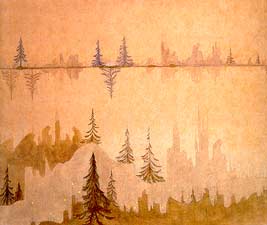
|
|
Fig.3. The picture "Fugue" by M.-K. Chiurlionis. |
The central image in Chiurlionis' "Fugue", its theme, is a fir-tree. On the
lower part of the picture - in the exposition (by analogy with music) it
dominates (has larger size and more dark colour). It is accompanied by the
images of Lithuanian fairy-tale kings sitting in sorrow; but their
colouring is more pale, less significant, likely to the counterpart
in music. The exposition with its main images smoothly flows into the
elaboration that is of a larger scale and more light colouring. It has
analogy to music - the elaboration development is usually characterized
by intensive tonal modulation that changes the colouring of the theme.
The third part of the picture - a reprise - is very clearly delimited. Just
as it is in music, the artist applied here more efficient and constructive
means - stretta and the mirror reflection of the theme at the same time.
Contrary to real optical laws, the fir-tree does not reflect in the water
exactly opposite, but with a displacement, similarly to the themes in
the fugue music.
The artist's conversion to the fugue form, in his first attempt to master a
new approach in painting, was not occasional. Fugue is one of the most
clearly constructed musical forms. Usually in music it serves as a
laboratory of composer, where he perfects his skill. Also we would remind
you that, for Chiurlionis as a composer, fugue was one of the most favourite
musical forms.
His conversion to sonata form in painting was not occasional too. Being the
multi-part composition, sonata gives an opportunity to develop an idea in a
long duration and to use contrast as one of the main means of development.
As an example, let us analyze the first work of the cycle "The Sun Sonata"
(1907). It consists of four pictures entitled "Allegro", "Andante", "Scherzo",
"Final" , which is the complete analog of the classical sonata structure in
music. These analogies are very clearly observed also in the principle of the
pictorial material arrangement, in tonal and thematic contrasting, etc. For
example, in the first picture - "Allegro" - the two images are present: The
Sun (the main part, by analogy with music) and The Castle (the side part).
They are contrasting in their colour (yellow and blue), similarly to tonal
contrasting of two themes in music (the main part is in the basic, and the
side-line is in the dominant tonality). In the picture the three parts are
clearly read (if it is viewed from down up), similarly to the musical form
of sonata's allegro - exposition, elaboration and reprise (the elaboration,
likely to music, being twice as much in size as reprise). Also noteworthy
is the colouring convergence of the two themes in the reprise (like in
music, where both themes usually sound in the same tonality). The tempo's
contrast is also equivalently embodied by pictorial means. The slow rhythm
of broad sun beams is clearly associated with slow tempo of the second
parts of musical sonatas. The fourth part of the cycle - "Final" - is of
particular interest. In the music of Vienna classics the final preferably
had the form of rondo (circle). In the picture there is painted a
bell, which tongue is wound round with a spiderweb. On the border of the
bell, imitatively to music reprise, the diminished images of the previous
three parts are placed.
Chiurlionis' next "Sonatas" were created also in accordance with the same laws
of musical form, though the musical idea was interpreted in a various ways.
In some of them he stepped closer to music ("The Spring Sonata"), while in the
others he sort of tried "to stay within the bounds of painting" ("The Sea
Sonata"). But the value of all Chiurlionis' pictorial "sonatas" lies in the
fact that they can be conceived as an original painting by the one who does
not even comprehend nor understand all the fine points of the musical form
manifestation in them. Being fantastic and not ordinary, this painting
always reflects the shapes of the real world, though in a symbolic and
cosmicremote form.
|
|
|
Fig.4. One part of a pictorial "Sonata of Pyramids" by Chiurlionis. |
To our opinion, those Chiurlionis' pictorial works are of particular interest,
which have much in common with Scriabin's musical works also in respect of
their content. Among the pictorial works of the medium period Chiurlionis
had a cycle inspired by the dream of harmony and beauty - "The Creation of
the World" (1905-1906). It consists of 13 paintings. The following to the
Bible legend shows only at the very beginning, in the third painting: an
enormous hand stretches through the space. "Let it be" - is written in the
corner of the picture. And the light is being borned, and the life together
with it: the sea corals, mushrooms, flowers. The world is filling with
colour and light. It is moving from chaos towards harmony. In the 12th
painting this harmonic principle is symbolized by the harps. In the last
painting there is a shadow of a wise, according to Lithuanian mythology,
Grass-snake. The evolution from Chaos - through Beauty and Harmony -
towards Mind is obvious.
It seemed interesting to us to compare this Chiurlionis' cycle with
Scriabin's "Prometheus" and make sure of their "unplanned", unexpected
likeness. Indeed, the pathos of Chiurlionis' cycle is in the creativity,
the creation of the world. Scriabin's "Prometheus" also is not a mere
illustration of the myth, and the main theme of "The Poem of Fire" is the
creation of Spirit, his triumph. Finally, both Scriabin and Chiurlionis
had made a hymn to creation power.
This hymnic idea was embodied in Chiurlionis' artworks in the transition from
graphical contrasts of the dead forms and planes towards the complex elaborated
composition, towards the motion of triumphant light. Just as the beginning of
Scriabin's "Prometheus" symbolizes the initial chaos, the initial undivided
spiritual being that transits through the stage of materialization and then
ascends again (the Spirit - the matter - the Spirit). The thematic principle
is expressed in the last two paintings of Chiurlionis' cycle - this is the
Harmony and the Mind (the Harp and the Grass-snake). And Scriabin's
"Prometheus" has two main images - the theme of "Creating Principle" and
the theme of "Mind". To add in conclusion: the colour scale in Chiurlionis'
paintings changes from black-blue somber cosmic chaos, through light green,
to bright colourfull flowering, while in Scriabin's "Luce" score of
"Prometheus" a slow light-voice moves from violet through blue part of
pectrum to red and then, again, to violet. In a mere schematic sense, the
colour cycle appears to be closed. But, as we know it from the reminiscences
of contemporaries, Scriabin planned a dazzling light in the final of
"Prometheus", on the contrary to the actual "Luce" design. So, once again -
from dark to light.
Thus, the closeness, similarity, is obvious even in such details. This
confirms Roerich's reflections expressed in passing in his article on
Chiurlionis in 1936: "Scriabin and Chiurlionis have much in common. And the
very tempers of these two geniuses have many allied streaks... Owing to
their singularity and convincingness, both these artists, each in his own
field, stirred up a great number of young minds" (cited from
[12, p.139].
These "own fields" are very distinct just in the manifestations of their
aspiration to the art synthesis. This is Scriabin whom we call "a pioneer
of light-music". Chiurlionis was not directly connected with light-music.
Though, according to some popular edition, his idea of "musical painting"
was inspired by the description of "colour music" in a "Clue to the
Mysteries of Nature" - the book written by German mystic of 18 century
Ecchartshousen
[13, p.97].
The author of the first Russian work on Chiurlionis (published even before
1917) reminds of the experiments with "Chladni figures", that is close
to light-music
[14 p.5].
No, the "musical painting" of the outstanding Lithuanian is not light-music,
it is painting, though organized according to the laws of musical mode
of thinking and form. (The only and rather small reason to assert his
advance and eventual coming to the light music is the draft of the scene
design for opera "Yurate", which he did not put on the stage by himself:
"Everything must appear gradually, the more light every next moment - the
music follows light and gradually comes to an end"
[15, p.240]).
But, to consider it in terms of wide aesthetic categories, the significance
of Chiurlionis for the development of various real forms of audiovisual
(painting-musical) synthesis is, of course, undoubtful. And the value of
his "musical painting" is also apparent and recognized. (Romen Rolland
named it as "new spiritual continent" and Chiurlionis himself as "Columbus").
Of course, we may imagine, in a genre of mental experiment, what things
might have happened if such composers as Scriabin and artists as
Chiurlionis or Kandinsky had united in one project. But the history
of art, just as the history on the whole, does not have the subjunctive mood.
Thus, we have to wait and work by ourselves...
BIBLIOGRAPHY
- Vanechkina I. L. Where does "The Blue Rider" Gallop?
(Schoenberg, Kandinsky and Scriabin: on the synthesis of art). - In: Schoenberg
and Kandinsky. An historic encounter. - Haag, Harwood acad. publ., 1998.
- Levaya T. N. Scriabin and the new Russian painting: from Modernism
to Abstractionism. In: "Nizhegorodsky Scriabin's Almanac", N1. - Nizhny
Novgorod, 1994. (in Russian)
- Fedotov V. M. Polyphony in the Paintings
of M. K. Chiurlionis. - "Leonardo", v.28, N 1, 1995, pp. 83-86.
- Galeyev B. M.The Fire of Prometheus... -
"Leonardo", v.21, N 4, pp.383-396.
- Galeyev B. M.The Conference on Scriabin. - "Leonardo", v.26,
N 1, 1994, pp.5-6.
- Sabaneyev L. The Reminiscences on Scriabin. - Moscow:
Rosmusizdat, 1925. (in Russian)
- Rosiner F. The Art of Chiurlionis. - Moscow: Terra,
1993. (in Russian)
- Landsbergis V. The Spring Sonata: the Creative Work of
M. K. Chiurlionis. - Leningrad: Muzyka, 1971. (in Russian)
- Fedotov V. M. The Musical Basement of Chiurlionis' Creative Method.
- Saratov: Saratov State University Press, 1989. (in Russian)
- Vanechkina I. L., Galeev B. M. The Poem of Fire
(Scriabin's Conception of the Light-Music Synthesis). - Kazan: Kazan State
University Press, 1981. (in Russian)
- Vanechkina I. L. "Luce" - the Beam That
Lightens the Problem of Harmony in Late Scriabin. - In: A. N. Scriabin
(Man, Artist, Thinker). - Moscow, 1994. (in Russian)
- Etkind M. The World as a Great Symphony. - Leningrad:
Iskusstvo, 1970. (in Russian)
- Voronova O. The Native Land, Lithuania... - In: As
the Century Goes by, vol. 2. - Moscow: Molodaya Gvardiya, 1969. (in Russian)
- Leman B. A. Chiurlionis. - Petrograd, 1917. (in Russian)
- Chiurlionis M. K. On Music and Painting. - Vilnius:
Vaga, 1960. (in Russian)
Available for publication in foreign journals.

